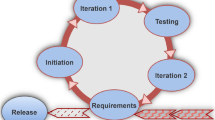Abstract
Software design is an area where it is most important to elicit an accurate and complete set of requirements. Determining the users’ requirements and their qualitative satisfaction with a developing product are two major problems which arise, often due to the different backgrounds and perspectives of the different stakeholders, including the software engineer, the domain expert and the end-user. Involving users throughout the design and development process is an essential part of any project. Computer-based interviewing has been found to be a valuable tool in eliciting information, which can also enhance interpersonal communication afterwards. This paper discusses the development of a computer interviewing tool to facilitate the gathering of user requirements and conducting user evaluations.






Similar content being viewed by others
References
Slack WV, Hicks GP, Reed CE, van Cura LJ (1966) A computer-based medical-history system. New Engl J Med 274:194–198
Dove GAW et al. (1977) The therapeutic effect of taking a patient’s history by computer. J R Coll Gen Pract 27:477–481
Millstein SG (1987) Acceptability and reliability of sensitive information collected via computer interview. Educ Psychol Meas 47:523–533
Locke SE, Kowaloff HB, Hoff RG, Safran C, Popovsky MA, Cotton DJ, Kinkelstein DM, Page PL, Slack WV (1992) Computer-based interview for screening blood donors for risk of HIV transmission. J Am Assoc 268:1301–1305
Gaines BR, Shaw MLG (1984) The art of computer conversation. Prentice Hall International, Englewood Cliffs, NJ
Peiris DR (1995) Computer interviews: enhancing their effectiveness by simulating interpersonal techniques. PhD thesis, The University of Dundee
Shneiderman B (1998) Designing the user interface: strategies for effective human-computer interaction, 3rd edn. Addison-Wesley, Reading MA
Isaacs EA (1997) Interviewing customers: discovering what they can’t tell you. In: Looking to the future: Proceedings of CHI’97, vol 2. ACM, New York, pp 180–181
Kotonya G, Sommerville I (1998) Requirements engineering: processes and techniques. Wiley, Chichester, UK
Preece J (ed) (1993) A guide to usability: human factors in computing. Addison Wesley, Wokingham, UK
Flynn DJ (1992) Information systems requirements: determination and analysis. McGraw-Hill, London
Quatrani T (2000) Visual modelling with rational rose and UML 2000, Addison-Wesley, Boston
Garrett A, Mangold MM, Zaki EP (1982) Interviewing: its principles and methods, Family Service America, WI
Boumphrey F et al. (2000) Beginning XHTML. Wrox Press, Hoboken, NJ
Nielsen J (1993) Usability engineering. Academic, Boston
Lazar J (2001) User-centered Web development. Jones and Bartlett, Sudbury, MA
Cato J (2001) User-centered Web design. Addison-Wesley, Harlow, UK
Lynch JL, Horton S (1999) Web style guide: basic design principles for creating Web sites. Yale University, New Haven, CT
Spool JM, Scanlon T, Schroeder W, Snyder C, DeAngelo T (1999) Web site usability: a designer’s guide. Morgan Kaufmann, San Francisco
Thatcher J, Bohman P, Burks M, Lawton Henry S, Regan B, Swierenga S, Urban MD, Waddell CD (2002) Constructing accessible Web sites. glasshaus, Birmingham, UK
Gould JD, Boies SJ, Ukelson J (1988) How to design usable systems. In: Helander M (ed) Handbook of human–computer interaction. North-Holland, Amsterdam, pp 231–254
Acknowledgements
EPSRC funded this research project, the UsE-IT (Usability Engineering–Interviewing Tool) project. Thanks are due to Iain Kay, who aided in the development of the interview authoring tool.
Author information
Authors and Affiliations
Corresponding author
Appendix
Appendix
- Interviewees:
-
Details of each interviewee and the date/time that their details were recorded.
- Authors:
-
Details of authors, including their password for accessing the interview-authoring interface. Authors can only edit interviews that they created.
- Interviews:
-
Details of each interview, including which author created the interview.
- IntervieweeInterviews:
-
A linking table between interviewees and interviews. Contains details of whether the interview is in progress or completed, how many times the interviewee has attempted the interview and how many times they have completed it.
- Questions:
-
Contains the question text and question type. The Question TypeID controls how the question is displayed.
- InterviewQuestions:
-
A linking table between interviews and questions enabling questions to be a part of more that one interview. Contains details of the question priority, the topic and whether it is mandatory (must be answered).
- IntervieweeQuestions:
-
A set of “working questions” for the current interviewee.
- QuestionTypes:
-
A list of question types, which is used to control how the question is displayed and how the answer is saved.
- QuestionTopics:
-
Details of the question topics so that questions can be grouped into different topics.
- Answers:
-
Details of the answers, including when the answer was saved and whether a comment has been added.
- AnswerOptions:
-
Details of the answer choices available for multiple-choice, checkbox and drop-down list questions.
- AnswerKeywords:
-
Details of keywords required for answer interpretation.
- AnswerRules:
-
Details of rules required for answer interpretation.
- AnswerActionsTopics:
-
Details of priority changes to be carried out to groups of questions of a particular topic.
- AnswerActionsQuestions:
-
Details of priority changes to be carried out to individual questions.
Rights and permissions
About this article
Cite this article
Hands, K., Peiris, D.R. & Gregor, P. Development of a computer-based interviewing tool to enhance the requirements gathering process. Requirements Eng 9, 204–216 (2004). https://doi.org/10.1007/s00766-003-0185-x
Received:
Accepted:
Published:
Issue Date:
DOI: https://doi.org/10.1007/s00766-003-0185-x




